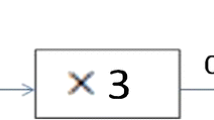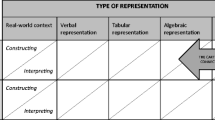Abstract
As part of a larger study of student understanding of concepts in linear algebra, we interviewed 10 university linear algebra students as to their conceptions of functions from high school algebra and linear transformation from their study of linear algebra. An overarching goal of this study was to examine how linear algebra students see linear transformation as related to high school function. Analysis of these data led to a characterization of student responses into three categories of mathematical structures used to discuss function: properties, computations, and a series of five interrelated clusters of metaphorical expressions. In this paper, we use this analytic framing for exploring the question: to what extent does each of the students in this study have a unified concept image of function across two mathematical contexts, high school algebra and their study of linear algebra? We found that students who expressed a unified notion of function used metaphorical language to bridge any gaps between the notion of function from high school and the notion of linear transformation from linear algebra. We conjecture that the framing of computations, properties, and metaphorical clusters could be extended to discussions of functions in contexts with other mathematical domains. Future research that further examines the extent to which undergraduate students develop a unified concept image of function could then lead to various design research efforts aimed at explicitly fostering such a unified understanding.
Similar content being viewed by others
Notes
As noted above, Brad is coded here as Pmap instead of Map because in his written work he does not make clear that he is not simply referencing a memorized relationship. In his verbal explanation he makes this distinction more clear.
References
Andrews-Larson, C., Wawro, M., & Zandieh, M. (2016). A hypothetical learning trajectory for conceptualizing matrices as linear transformations. Manuscript submitted for publication.
Artigue, M. (1992). Cognitive difficulties and teaching practices. In G. Harel & E. Dubinsky (Eds.), The concept of function: Aspects of epistemology and pedagogy (pp. 109–132). Washington, DC: The Mathematical Association of America.
Bagley, S., Rasmussen, C., & Zandieh, M. (2015). Inverse, composition, and identity: the case of function and linear transformation. Journal of Mathematical Behavior, 37, 36–47.
Breidenbach, D., Dubinsky, E., Hawkes, J., & Nichols, D. (1992). Development of the process conception of function. Educational Studies in Mathematics, 23(3), 247–285.
Carlson, M. P. (1998). A cross-sectional investigation of the development of the function concept. In A. H. Schoenfeld, J. Kaput, & E. Dubinsky (Eds.), CBMS issues in mathematics education: Research in Collegiate Mathematics Education (Vol. 3, pp. 114–162). Providence: American Mathematical Society.
Carlson, M., Jacobs, S., Coe, E., Larsen, S., & Hsu, E. (2002). Applying covariational reasoning while modeling dynamic events: A framework and a study. Journal for Research in Mathematics Education, 33(5), 352–378.
Carlson, D., Johnson, C., Lay, D., & Porter, A. D. (1993). The Linear Algebra Curriculum Study Group recommendations for the first course in linear algebra. The College Mathematics Journal, 24(1), 41–46.
Dreyfus, T., Hillel, J., & Sierpinska, A. (1998). Cabri-based linear algebra: Transformations. European Research in Mathematics Education I, 209–221.
Dubinsky, E., & McDonald, M. (2001). APOS: A constructivist theory of learning in undergraduate mathematics education research. In D. Holton, M. Artigue, U. Krichgraber, J. Hillel, M. Niss, & A. Schoenfeld (Eds.), The teaching and learning of mathematics at university level: An ICMI Study (pp. 273–280). Dordrecht: Kluwer.
Fauconnier, G., & Turner, M. (2002). The way we think: Conceptual blending and the mind’s hidden complexities. New York: Basic Books.
Glaser, B., & Strauss, A. (1967). The discovery of grounded theory: Strategies for qualitative research. Chicago: Aldine Publishing Company.
Gowers, T., Barrow-Green, J., & Leader, I. (Eds.). (2010). The Princeton companion to mathematics. Princeton University Press.
Harel, G., & Dubinsky, E. (Eds.). (1992). The concept of function: Aspects of epistemology and pedagogy. MAA Notes (Vol. 25). Washington, DC: The Mathematical Association of America.
Lakoff, G., & Johnson, M. (1980). Metaphors we live by. Chicago: The University of Chicago Press.
Lakoff, G., & Núñez, R. (2000). Where mathematics comes from: How the embodied mind brings mathematics into being. New York: Basic Books.
Lay, D. C. (2006). Linear algebra and its applications (3rd ed.). Reading, MA: Addison-Wesley.
Monk, G. (1992). Students’ understanding of a function given by a physical model. In G. Harel & E. Dubinsky (Eds.), The concept of function: Aspects of epistemology and pedagogy (pp. 175–193). Washington, DC: The Mathematical Association of America.
National Council of Teachers of Mathematics (Ed.). (2000). Principles and standards for school mathematics (Vol. 1). Reston, VA: National Council of Teachers of Mathematics.
Oehrtman, M. (2009). Collapsing dimensions, physical limitation, and other student metaphors for limit concepts. Journal for Research in Mathematics Education, 40, 396–426.
Oehrtman, M. C., Carlson, M. P., & Thompson, P. W. (2008). Foundational reasoning abilities that promote coherence in students’ understandings of function. In M. P. Carlson & C. Rasmussen (Eds.), Making the connection: Research and practice in undergraduate mathematics (pp. 150–171). Washington, DC: Mathematical Association of America.
Portnoy, N., Grundmeier, T. A., & Graham, K. J. (2006). Students’ understanding of mathematical objects in the context of transformational geometry: Implications for constructing and understanding proofs. Journal of Mathematical Behavior, 25, 196–207.
Rasmussen, C. (2001). New directions in differential equations: A framework for interpreting students’ understandings and difficulties. Journal of Mathematical Behavior, 20, 55–87.
Sfard, A. (1991). On the dual nature of mathematical conceptions: Reflections on processes and objects as different sides of the same coin. Educational Studies in Mathematics, 22(1), 1–36.
Sfard, A. (1992). Operational origins of mathematical objects and the quandary of reification – The case of function. In G. Harel & E. Dubinsky (Eds.), The concept of function: Aspects of epistemology and pedagogy (pp. 59–84). Washington, DC: The Mathematical Association of America.
Stewart, J. (2007). Essential calculus: Early transcendentals (4th ed.). Belmont, CA: Thomson Higher Education.
Tall, D., & Vinner, S. (1981). Concept image and concept definition in mathematics, with special reference to limits and continuity. Educational Studies in Mathematics, 12(2), 151–169.
Thompson, P. W. (1995). Students, functions, and the undergraduate curriculum. In E. Dubinsky, A. H. Schoenfeld, & J. Kaput (Eds.), Research in Collegiate Mathematics Education (Vol. 1, pp. 21–44). Washington, DC: Conference Board on the Mathematical Sciences.
Vinner, S. (1991). The role of definitions in the teaching and learning of mathematics. In D. Tall (Ed.), Advanced mathematical thinking (pp. 65–79). Dordrecht, Netherlands: Kluwer.
Vinner, S., & Dreyfus, T. (1989). Images and definition for the concept of function. Journal for Research in Mathematics Education, 20, 356–366.
Wawro, M., Sweeney, G., & Rabin, J. M. (2011). Subspace in linear algebra: Investigating students’ concept images and interactions with the formal definition. Educational Studies in Mathematics, 78, 1–19.
Wilson, M. R. (1993). One preservice teacher’s evolving understanding of mathematical functions. Paper presented at the Annual Meeting of the American Educational Research Association, Atlanta, GA.
Zandieh, M. (2000). A theoretical framework for analyzing student understanding of the concept of derivative. Research in Collegiate Mathematics Education (Vol. 4, pp. 103–127). Washington, DC: Conference Board on the Mathematical Sciences.
Zandieh, M., & Knapp, J. (2006). Exploring the role of metonymy in mathematical understanding and reasoning: The concept of derivative as an example. Journal of Mathematical Behavior, 25, 1–17.
Zandieh, M., & Rasmussen, C. (2010). Defining as a mathematical activity: A framework for characterizing progress from informal to more formal ways of reasoning. Journal of Mathematical Behavior, 29, 57–75.
Author information
Authors and Affiliations
Corresponding author
Rights and permissions
About this article
Cite this article
Zandieh, M., Ellis, J. & Rasmussen, C. A characterization of a unified notion of mathematical function: the case of high school function and linear transformation. Educ Stud Math 95, 21–38 (2017). https://doi.org/10.1007/s10649-016-9737-0
Published:
Issue Date:
DOI: https://doi.org/10.1007/s10649-016-9737-0




